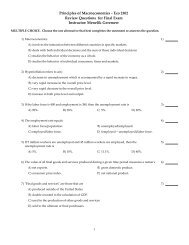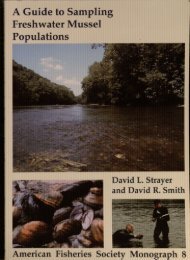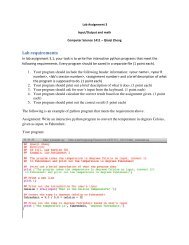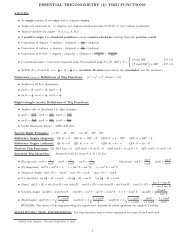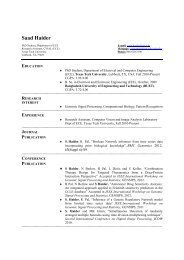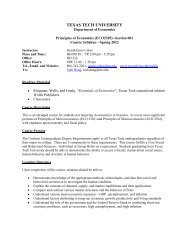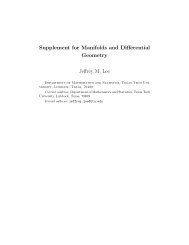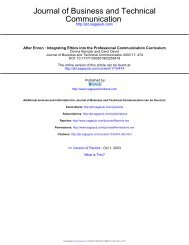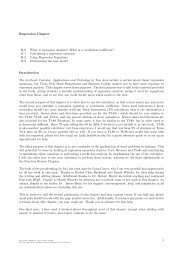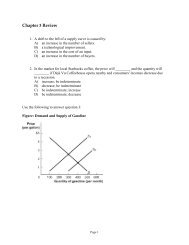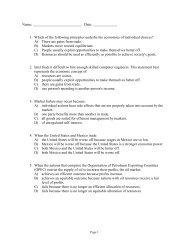Download - MyWeb - Texas Tech University
Download - MyWeb - Texas Tech University
Download - MyWeb - Texas Tech University
Create successful ePaper yourself
Turn your PDF publications into a flip-book with our unique Google optimized e-Paper software.
Archaeo-geophysical Survey of the Upper Plaza<br />
filtering and despiking. High pass filtering<br />
calculates the mean of a window of a specified<br />
size, and then subtracts this mean from the<br />
center value. This is typically done using either<br />
Uniform or Gaussian weighting. With Uniform<br />
weighting means, all values within the window<br />
are given equal weight. Gaussian weighting<br />
gives a higher weight to values closer to the<br />
center of the window. With respect to resistivity<br />
data, the high pass filter is commonly used to<br />
remove the geological background readings<br />
from the data (Somers 2006:118–119). In<br />
addition, despiking is often used to remove<br />
outliers from the dataset. A uniform weighted<br />
window is passed through the data set to remove<br />
all values exceeding a specified threshold. Both<br />
the window size and threshold are adjustable,<br />
and mean or median values can be used for the<br />
threshold. In resistivity data, such outliers are<br />
often erroneous readings.<br />
Electromagnetic Induction (Conductivity)<br />
Data Processing<br />
Of the geophysical technologies employed<br />
in the current survey EM is the most straight<br />
forward to process. Data files are simply<br />
exported as XYZ files from the GeoMar<br />
TrackMaker data collection software. These<br />
data are then gridded in Surfer, exported as<br />
images, and then geo-referenced in ArcGIS.<br />
Survey Methods<br />
The geophysical survey at the Chan Chich was<br />
located in the site’s Upper Plaza. A 20-x-40-m<br />
collection grid was established using 50-m<br />
measuring tapes and a total data station, which<br />
was used to establish angles but not distances<br />
(Figure 2.1). The grid was oriented on a north/<br />
south axis, which is roughly aligned with the<br />
general orientation of the upper plaza. The<br />
survey crew plotted the location of trees in the<br />
grid prior to conducting the survey (Figure 2.2).<br />
The entire collection area was covered with<br />
GPR at a 1-m line spacing. Resistance data was<br />
collected over as much of the total collection<br />
area as possible (given the amount of standing<br />
trees and rock on the plaza surface). Both the<br />
GPR and resistance data were processed and<br />
a 10-x-10-m collection grid was established<br />
over a series of interesting high amplitude<br />
reflections (Figure 2.2). The 10-x-10-m subset<br />
was recollected at high resolution with the<br />
GPR and EM. High resolution GPR data were<br />
collected along both the x and y axis at 25-cm<br />
line spacing. EM data were collected at 50-cm<br />
line spacing.<br />
Results<br />
The GPR data (Figure 2.3) show a series of high<br />
reflection anomalies (shown in red on these<br />
images). The 1-m data show high amplitude<br />
reflections in the northeast and western portions<br />
of the grid. The high amplitude reflections<br />
on the western portion of the 1-m GPR grid<br />
correspond well with a high resistance anomaly<br />
from the resistance survey (Figure 2.4).<br />
A 10-x-10-m grid was established over this<br />
GPR and resistance anomaly and additional<br />
data were collected as noted above. The high<br />
resolution GPR data increased the clarity of this<br />
anomaly (see inset on left side of Figure 2.3).<br />
This anomaly was chosen for testing due to its<br />
appearance in two of the geophysical data sets<br />
as well as its location in relation to the upper<br />
plaza. The results of these test excavations are<br />
discussed by Kelley et al. (this volume), but<br />
in general were areas of loosely consolidated<br />
construction fill. The EM data (Figure 2.5)<br />
was non-conclusive and only produced one<br />
anomaly that was caused by ferrous objects on<br />
the surface.<br />
Although the geophysical survey was<br />
unsuccessful in the Upper Plaza, I am optimistic<br />
that under the proper conditions one or more<br />
of the remote sensing techniques we tested<br />
at Chan Chich could prove useful on Maya<br />
11



